2013 NISSAN PATHFINDER weight
[x] Cancel search: weightPage 488 of 506

WARNING
Properly adjust the weight distributing
hitch so the rear of the bumper is no
higher than the measured reference
height when the trailer is attached. If the
rear bumper is higher than the measured
reference height when loaded, the vehicle
may handle unpredictably which could
cause a loss of vehicle control and cause
serious personal injury or property
damage.
Sway control device
Sudden maneuvers, wind gusts, and buffeting
caused by other vehicles can affect trailer han-
dling. Sway control devices may be used to help
control these affects. If you choose to use one,
contact a reputable trailer hitch supplier to make
sure the sway control device will work with the
vehicle, hitch, trailer and the trailer’s brake sys-
tem. Follow the instructions provided by the
manufacturer for installing and using the sway
control device.
Class I hitch
Class I trailer hitch equipment (receiver, ball
mount and hitch ball) can be used to tow trailers
of a maximum weight of 2,000 lb (907 kg) .
Class II hitch
Class II trailer hitch equipment (receiver, ball
mount and hitch ball) can be used to tow trailers
of a maximum weight of 3,500 lb (1,587 kg).
Class III hitch
Class III trailer hitch equipment (receiver, ball
mount and hitch ball) can be used to tow trailers
of a maximum weight of 5,000 lb (2,268 kg).
Tire pressures
●When towing a trailer, inflate the ve-
hicle tires to the recommended cold
tire pressure indicated on the tire
placard.
● Trailer tire condition, size, load rating
and proper inflation pressure should
be in accordance with the trailer and
tire manufacturer’s specifications.
Safety chains
Always use suitable safety chains between your
vehicle and the trailer. The safety chains should be
crossed and should be attached to the hitch, not to
the vehicle bumper or axle. The safety chains can
be attached to the bumper if the hitch ball is
mounted to the bumper. Be sure to leave enough
slack in the chains to permit turning corners.
Trailer lights
CAUTION
When splicing into the vehicle electrical
system, a commercially available power-
type module/converter must be used to
provide power for all trailer lighting. This
unit uses the vehicle battery as a direct
power source for all trailer lights while
using the vehicle tail light, stoplight and
turn signal circuits as a signal source. The
module/converter must draw no more
that 15 milliamps from the stop and tail
lamp circuits. Using a module/converter
that exceeds these power requirements
may damage the vehicle’s electrical sys-
tem. See a reputable trailer retailer to
obtain the proper equipment and to have
it installed.
Trailer lights should comply with federal and/or
local regulations. For assistance in hooking up
trailer lights, contact a NISSAN dealer or repu-
table trailer retailer. Vehicles equipped with the
optional trailer tow package are equipped with a
7-pin trailer harness connector. If your trailer is
equipped with a flat 4-pin connector, an adapter
will be needed to connect the trailer lights to the
vehicle. Adapters are available at auto parts
stores and hitch retailers.
Technical and consumer information9-23
Page 489 of 506
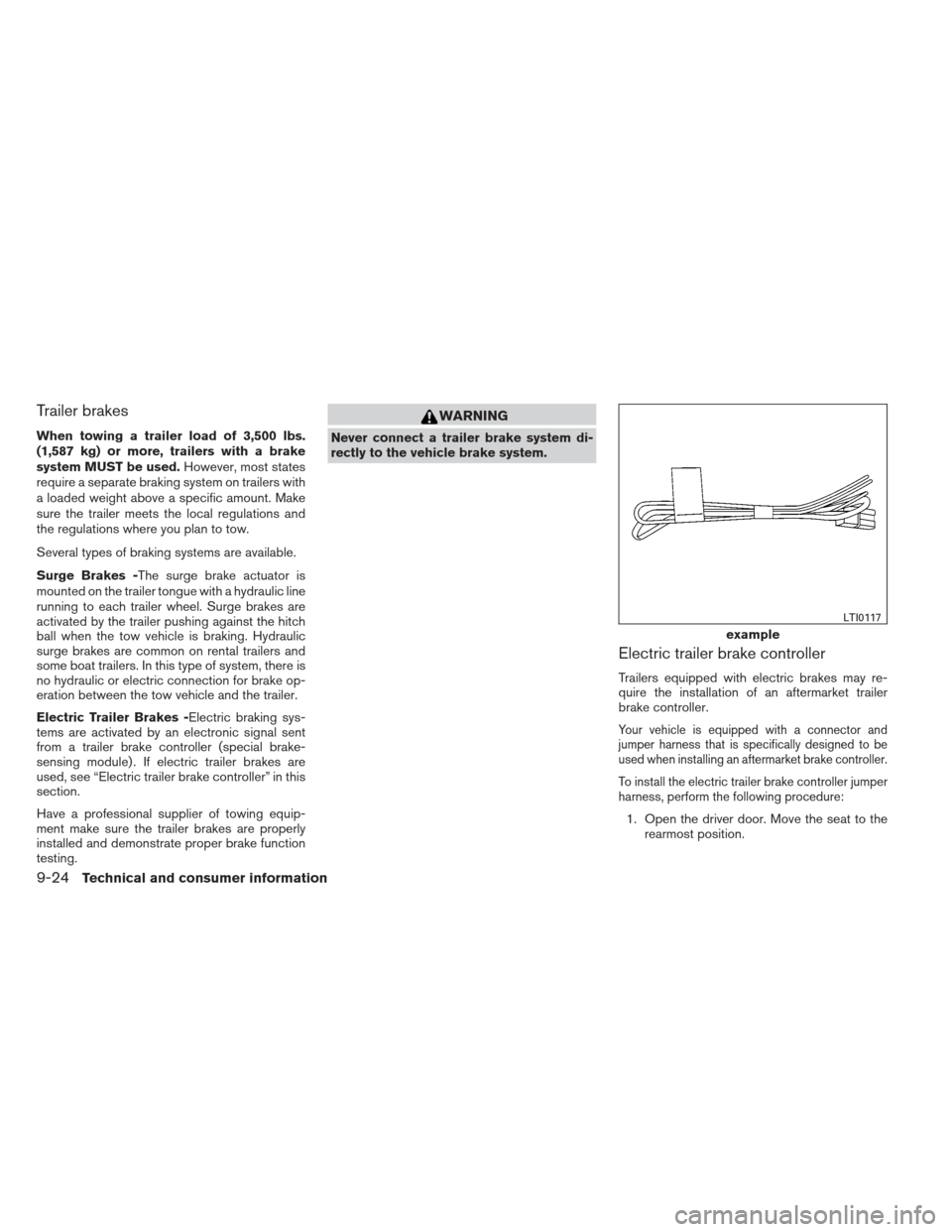
Trailer brakes
When towing a trailer load of 3,500 lbs.
(1,587 kg) or more, trailers with a brake
system MUST be used.However, most states
require a separate braking system on trailers with
a loaded weight above a specific amount. Make
sure the trailer meets the local regulations and
the regulations where you plan to tow.
Several types of braking systems are available.
Surge Brakes -The surge brake actuator is
mounted on the trailer tongue with a hydraulic line
running to each trailer wheel. Surge brakes are
activated by the trailer pushing against the hitch
ball when the tow vehicle is braking. Hydraulic
surge brakes are common on rental trailers and
some boat trailers. In this type of system, there is
no hydraulic or electric connection for brake op-
eration between the tow vehicle and the trailer.
Electric Trailer Brakes -Electric braking sys-
tems are activated by an electronic signal sent
from a trailer brake controller (special brake-
sensing module) . If electric trailer brakes are
used, see “Electric trailer brake controller” in this
section.
Have a professional supplier of towing equip-
ment make sure the trailer brakes are properly
installed and demonstrate proper brake function
testing.
WARNING
Never connect a trailer brake system di-
rectly to the vehicle brake system.
Electric trailer brake controller
Trailers equipped with electric brakes may re-
quire the installation of an aftermarket trailer
brake controller.
Your vehicle is equipped with a connector and
jumper harness that is specifically designed to be
used when installing an aftermarket brake controller.
To install the electric trailer brake controller jumper
harness, perform the following procedure:
1. Open the driver door. Move the seat to the rearmost position.
example
LTI0117
9-24Technical and consumer information
Page 492 of 506
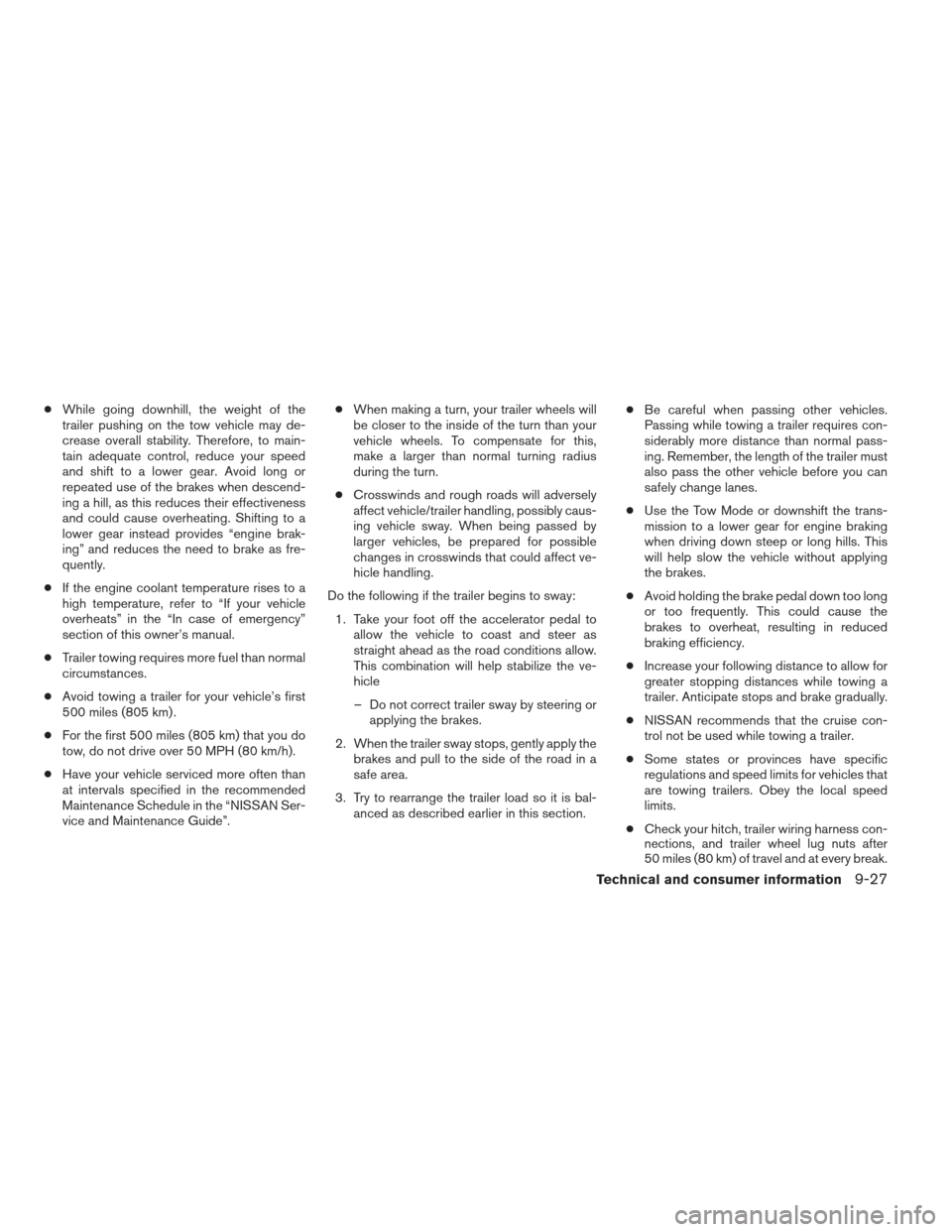
●While going downhill, the weight of the
trailer pushing on the tow vehicle may de-
crease overall stability. Therefore, to main-
tain adequate control, reduce your speed
and shift to a lower gear. Avoid long or
repeated use of the brakes when descend-
ing a hill, as this reduces their effectiveness
and could cause overheating. Shifting to a
lower gear instead provides “engine brak-
ing” and reduces the need to brake as fre-
quently.
● If the engine coolant temperature rises to a
high temperature, refer to “If your vehicle
overheats” in the “In case of emergency”
section of this owner’s manual.
● Trailer towing requires more fuel than normal
circumstances.
● Avoid towing a trailer for your vehicle’s first
500 miles (805 km) .
● For the first 500 miles (805 km) that you do
tow, do not drive over 50 MPH (80 km/h).
● Have your vehicle serviced more often than
at intervals specified in the recommended
Maintenance Schedule in the “NISSAN Ser-
vice and Maintenance Guide”. ●
When making a turn, your trailer wheels will
be closer to the inside of the turn than your
vehicle wheels. To compensate for this,
make a larger than normal turning radius
during the turn.
● Crosswinds and rough roads will adversely
affect vehicle/trailer handling, possibly caus-
ing vehicle sway. When being passed by
larger vehicles, be prepared for possible
changes in crosswinds that could affect ve-
hicle handling.
Do the following if the trailer begins to sway: 1. Take your foot off the accelerator pedal to allow the vehicle to coast and steer as
straight ahead as the road conditions allow.
This combination will help stabilize the ve-
hicle
– Do not correct trailer sway by steering or applying the brakes.
2. When the trailer sway stops, gently apply the brakes and pull to the side of the road in a
safe area.
3. Try to rearrange the trailer load so it is bal- anced as described earlier in this section. ●
Be careful when passing other vehicles.
Passing while towing a trailer requires con-
siderably more distance than normal pass-
ing. Remember, the length of the trailer must
also pass the other vehicle before you can
safely change lanes.
● Use the Tow Mode or downshift the trans-
mission to a lower gear for engine braking
when driving down steep or long hills. This
will help slow the vehicle without applying
the brakes.
● Avoid holding the brake pedal down too long
or too frequently. This could cause the
brakes to overheat, resulting in reduced
braking efficiency.
● Increase your following distance to allow for
greater stopping distances while towing a
trailer. Anticipate stops and brake gradually.
● NISSAN recommends that the cruise con-
trol not be used while towing a trailer.
● Some states or provinces have specific
regulations and speed limits for vehicles that
are towing trailers. Obey the local speed
limits.
● Check your hitch, trailer wiring harness con-
nections, and trailer wheel lug nuts after
50 miles (80 km) of travel and at every break.
Technical and consumer information9-27
Page 499 of 506
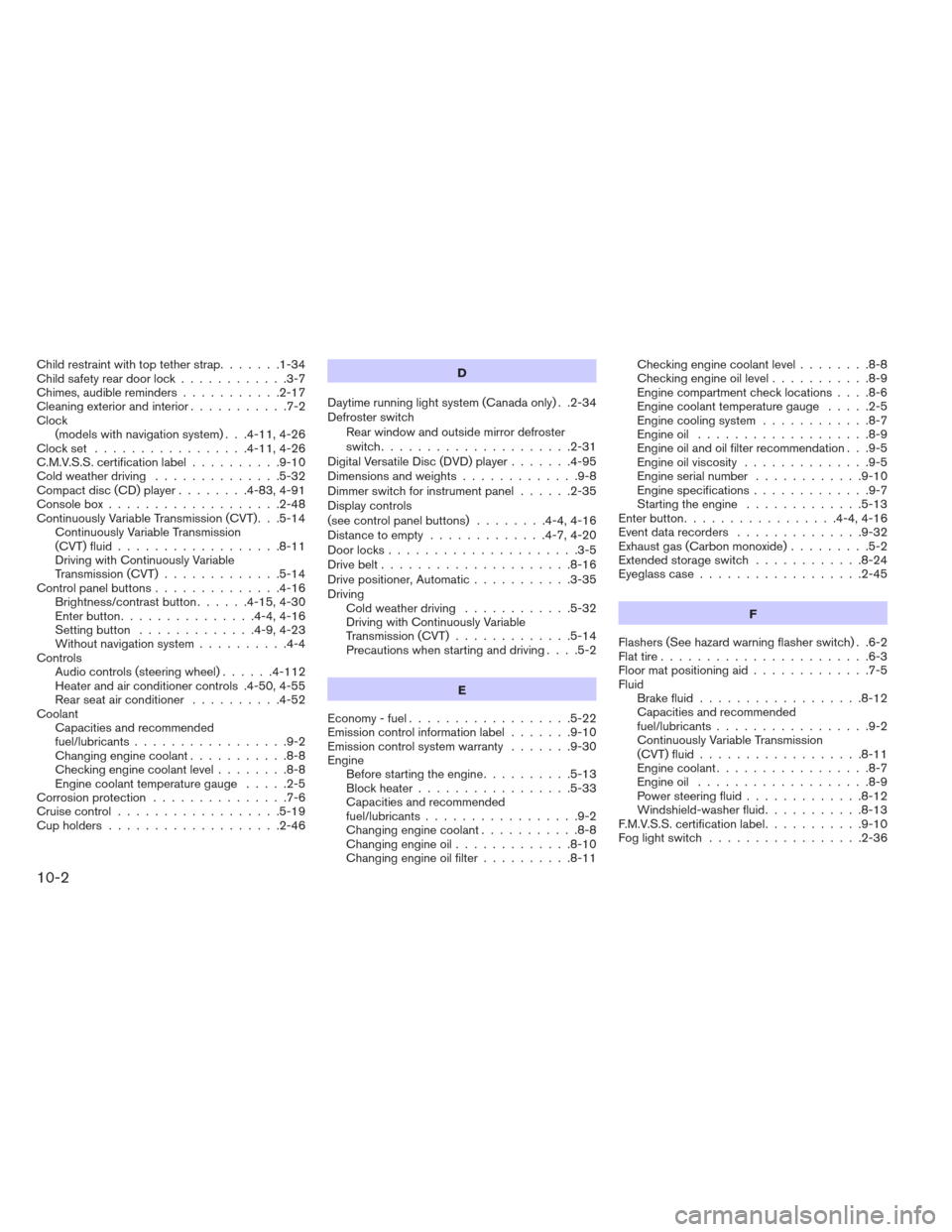
Child restraint with top tether strap.......1-34
Child safety rear door lock ............3-7
Chimes, audible reminders ...........2-17
Cleaningexteriorandinterior...........7-2
Clock (models with navigation system) . . .4-11, 4-26
Clockset .................4-11,4-26
C.M.V.S.S. certification label ..........9-10
Cold weather driving ..............5-32
Compact disc (CD) player ........4-83,4-91
Console box ...................2-48
Continuously Variable Transmission (CVT). . .5-14 Continuously Variable Transmission
(CVT) fluid ..................8-11
Driving with Continuously Variable
Transmission (CVT) .............5-14
Controlpanelbuttons..............4-16 Brightness/contrast button ......4-15,4-30
Enterbutton...............4-4,4-16
Setting button .............4-9,4-23
Without navigation system ..........4-4
Controls Audiocontrols(steeringwheel)......4-112
Heater and air conditioner controls .4-50, 4-55
Rear seat air conditioner ..........4-52
Coolant Capacities and recommended
fuel/lubricants .................9-2
Changing engine coolant ...........8-8
Checking engine coolant level ........8-8
Engine coolant temperature gauge .....2-5
Corrosionprotection ...............7-6
Cruise control ..................5-19
Cupholders...................2-46 D
Daytime running light system (Canada only) . .2-34
Defroster switch Rear window and outside mirror defroster
switch.....................2-31
Digital Versatile Disc (DVD) player .......4-95
Dimensionsandweights.............9-8
Dimmer switch for instrument panel ......2-35
Display controls
(seecontrolpanelbuttons) ........4-4,4-16
Distance to empty .............4-7,4-20
Door locks .....................3-5
Drive belt .....................8-16
Drive positioner, Automatic ...........3-35
Driving Cold weather driving ............5-32
Driving with Continuously Variable
Transmission (CVT) .............5-14
Precautions when starting and driving ....5-2
E
Economy - fuel ..................5-22
Emission control information label .......9-10
Emission control system warranty .......9-30
Engine Before starting the engine ..........5-13
Block heater .................5-33
Capacities and recommended
fuel/lubricants .................9-2
Changing engine coolant ...........8-8
Changing engine oil .............8-10
Changing engine oil filter ..........8-11 Checking engine coolant level
........8-8
Checking engine oil level ...........8-9
Engine compartment check locations ....8-6
Engine coolant temperature gauge .....2-5
Engine cooling system ............8-7
Engine oil ...................8-9
Engine oil and oil filter recommendation . . .9-5
Engine oil viscosity ..............9-5
Engine serial number ............
9-10
Engine specifications .............9-7
Starting the engine .............5-13
Enterbutton.................4-4,4-16
Eventdatarecorders ..............9-32
Exhaust gas (Carbon monoxide) .........5-2
Extended storage switch ............8-24
Eyeglass case ..................2-45
F
Flashers (See hazard warning flasher switch) . .6-2
Flat tire .......................6-3
Floor mat positioning aid .............7-5
Fluid Brake fluid ..................8-12
Capacities and recommended
fuel/lubricants .................9-2
Continuously Variable Transmission
(CVT)fluid..................8-11
Engine coolant .................8-7
Engine oil ...................8-9
Power steering fluid .............8-12
Windshield-washer fluid ...........8-13
F.M.V.S.S. certification label ...........9-10
Foglightswitch .................2-36
10-2
Page 503 of 506
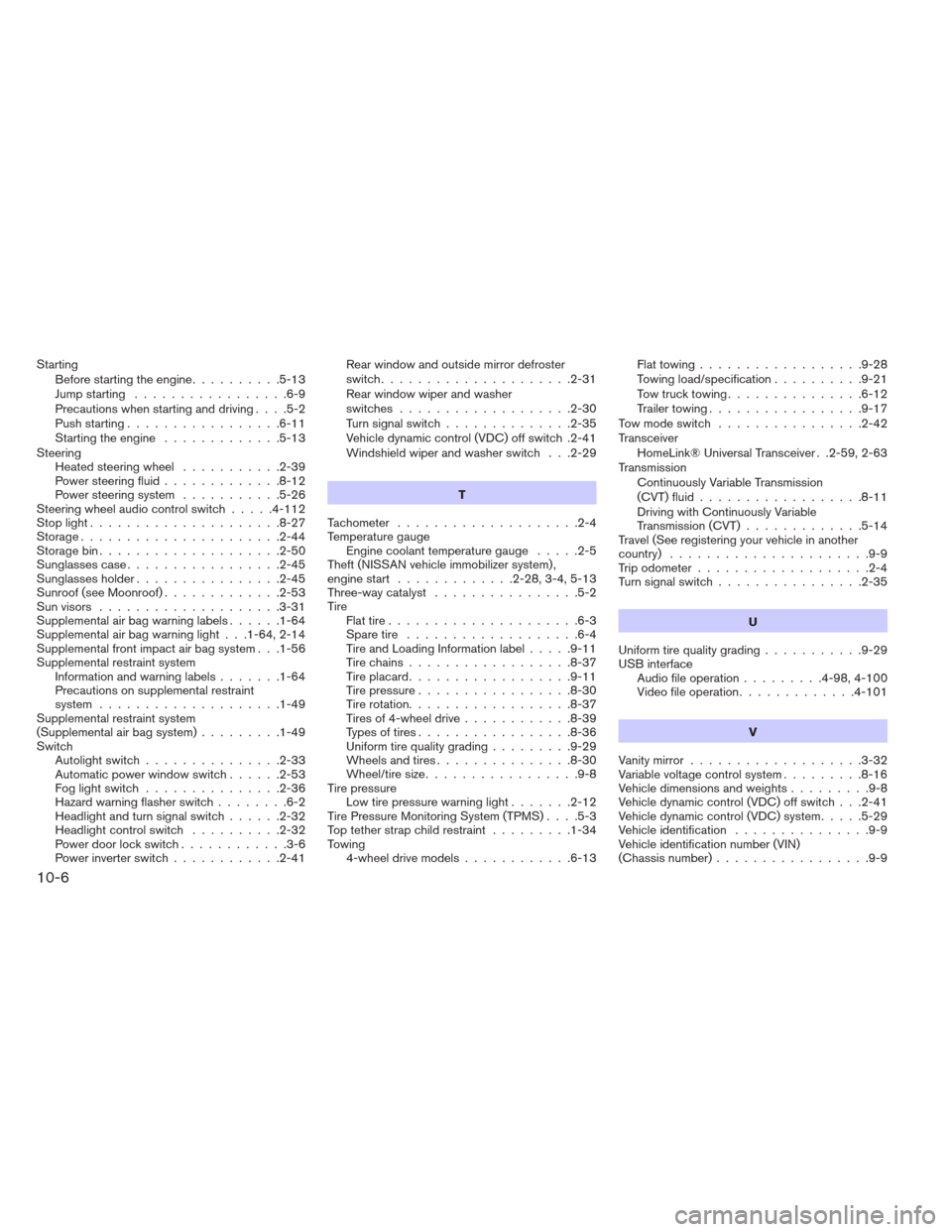
StartingBefore starting the engine ..........5-13
Jump starting .................6-9
Precautions when starting and driving ....5-2
Push starting .................6-11
Starting the engine .............5-13
Steering Heated steering wheel ...........2-39
Power steering fluid .............8-12
Power steering system ...........5-26
Steering wheel audio control switch .....4-112
Stoplight.....................8-27
Storage......................2-44
Storagebin....................2-50
Sunglassescase.................2-45
Sunglassesholder................2-45
Sunroof (see Moonroof) .............2-53
Sun visors ....................3-31
Supplemental air bag warning labels ......1-64
Supplemental air bag warning light . . .1-64, 2-14
Supplemental front impact air bag system . . .1-56
Supplemental restraint system Information and warning labels .......1-64
Precautions on supplemental restraint
system ....................1-49
Supplemental restraint system
(Supplemental air bag system) .........1-49
Switch Autolightswitch...............2-33
Automatic power window switch ......2-53
Foglightswitch ...............2-36
Hazard warning flasher switch ........6-2
Headlight and turn signal switch ......2-32
Headlightcontrolswitch ..........2-32
Power door lock switch ............3-6
Power inverter switch ............2-41 Rear window and outside mirror defroster
switch.....................2-31
Rear window wiper and washer
switches...................2-30
Turn signal switch
..............2-35
Vehicle dynamic control (VDC) off switch .2-41
Windshield wiper and washer switch . . .2-29
T
Tachometer ....................2-4
Temperature gauge Engine coolant temperature gauge .....2-5
Theft (NISSAN vehicle immobilizer system) ,
engine start .............2-28,3-4,5-13
Three-way catalyst ................5-2
Tire Flat tire .....................6-3
Spare tire ...................6-4
Tire and Loading Information label .....9-11
Tirechains..................8-37
Tireplacard..................9-11
Tire pressure .................8-30
Tire rotation..................8-37
Tires of 4-wheel drive ............8-39
Types of tires .................8-36
Uniform tire quality grading .........9-29
Wheels and tires ...............8-30
Wheel/tire size .................9-8
Tire pressure Low tire pressure warning light .......2-12
Tire Pressure Monitoring System (TPMS) ....5-3
Top tether strap child restraint .........1-34
Towing 4-wheel drive models ............6-13 Flattowing..................9-28
Towing load/specification
..........9-21
Tow truck towing ...............6-12
Trailer towing .................9-17
Towmodeswitch ................2-42
Transceiver HomeLink® Universal Transceiver . .2-59, 2-63
Transmission Continuously Variable Transmission
(CVT)fluid..................8-11
Driving
with Continuously Variable
Transmission (CVT) .............5-14
Travel (See registering your vehicle in another
country) ......................9-9
Trip odometer ...................2-4
Turn signal switch ................2-35
U
Uniform tire quality grading ...........9-29
USB interface Audio file operation .........4-98,4-100
Video file operation .............4-101
V
Vanity mirror ...................3-32
Variable voltage control system .........8-16
Vehicledimensionsandweights.........9-8
Vehicle dynamic control (VDC) off switch . . .2-41
Vehicle dynamic control (VDC) system .....5-29
Vehicle identification ...............9-9
Vehicle identification number (VIN)
(Chassis number) .................9-9
10-6
Page 504 of 506
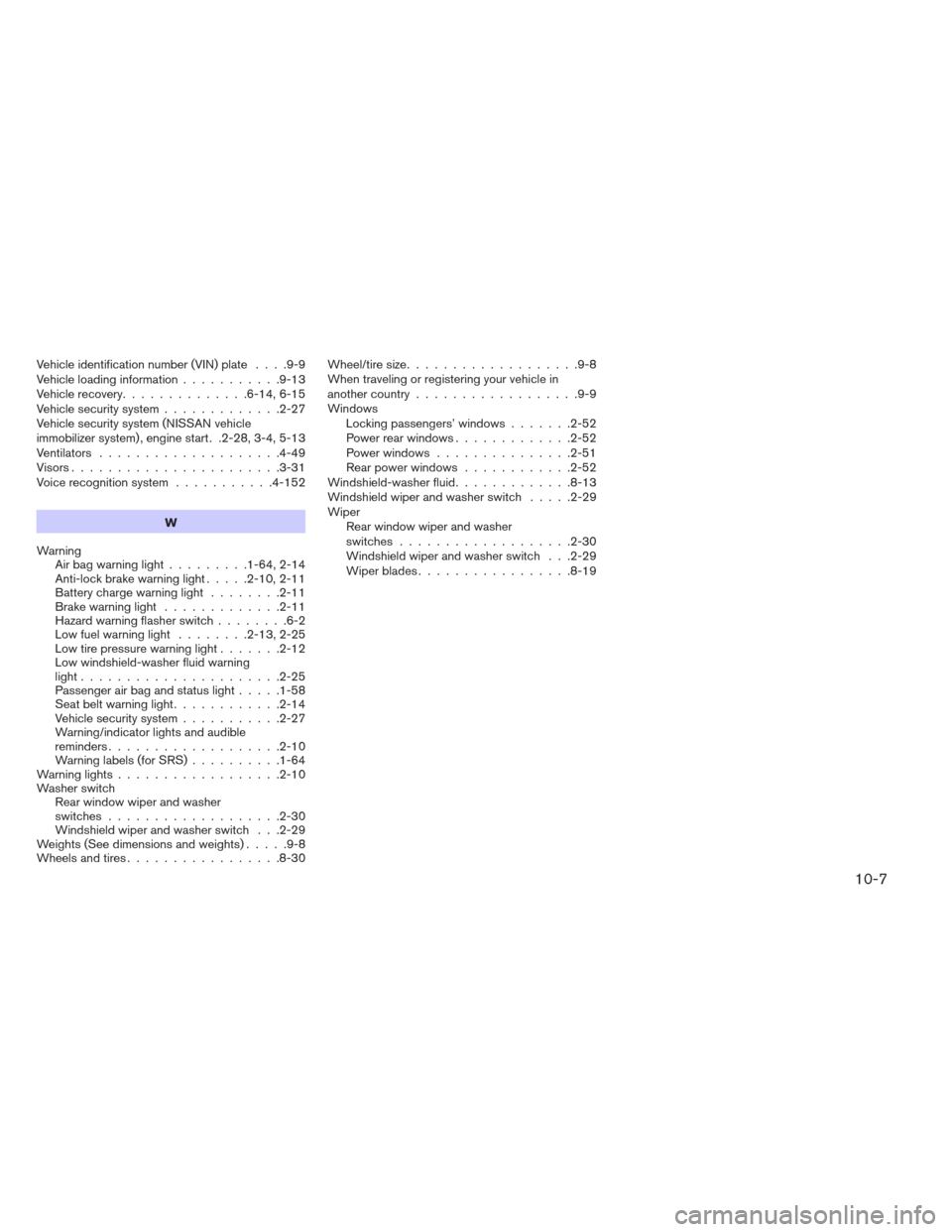
Vehicle identification number (VIN) plate....9-9
Vehicle loading information ...........9-13
Vehicle recovery ..............6-14,6-15
Vehicle security system .............2-27
Vehicle security system (NISSAN vehicle
immobilizer system) , engine start . .2-28, 3-4, 5-13
Ventilators ....................4-49
Visors.......................3-31
Voice recognition system ...........4-152
W
Warning Airbagwarninglight.........1-64,2-14
Anti-lock brake warning light .....2-10,2-11
Battery charge warning light ........2-11
Brakewarninglight .............2-11
Hazard warning flasher switch ........6-2
Lowfuelwarninglight ........2-13,2-25
Low tire pressure warning light .......2-12
Low windshield-washer fluid warning
light......................2-25
Passenger air bag and status light .....1-58
Seat belt warning light ............2-14
Vehicle security system ...........2-27
Warning/indicator lights and audible
reminders ...................2-10
Warning labels (for SRS) ..........1-64
Warninglights..................2-10
Washer switch Rear window wiper and washer
switches ...................2-30
Windshield wiper and washer switch . . .2-29
Weights(Seedimensionsandweights).....9-8
Wheels and tires .................8-30 Wheel/tire size
...................9-8
When traveling or registering your vehicle in
another country ..................9-9
Windows Locking passengers’ windows .......2-52
Power rear windows .............2-52
Power windows ...............2-51
Rear power windows ............2-52
Windshield-washerfluid.............8-13
Windshieldwiperandwasherswitch .....2-29
Wiper Rear window wiper and washer
switches...................2-30
Windshield wiper and washer switch . . .2-29
Wiperblades.................8-19
10-7